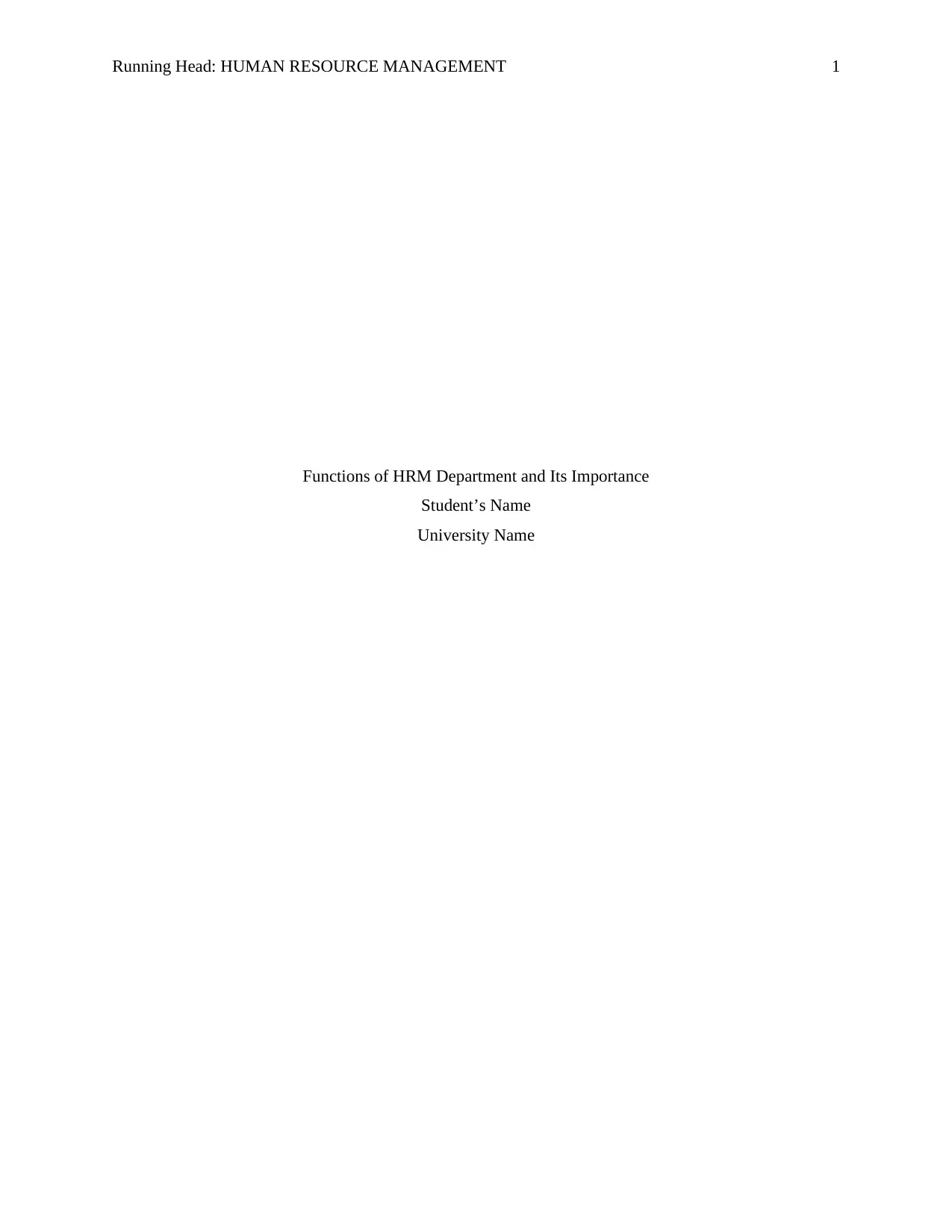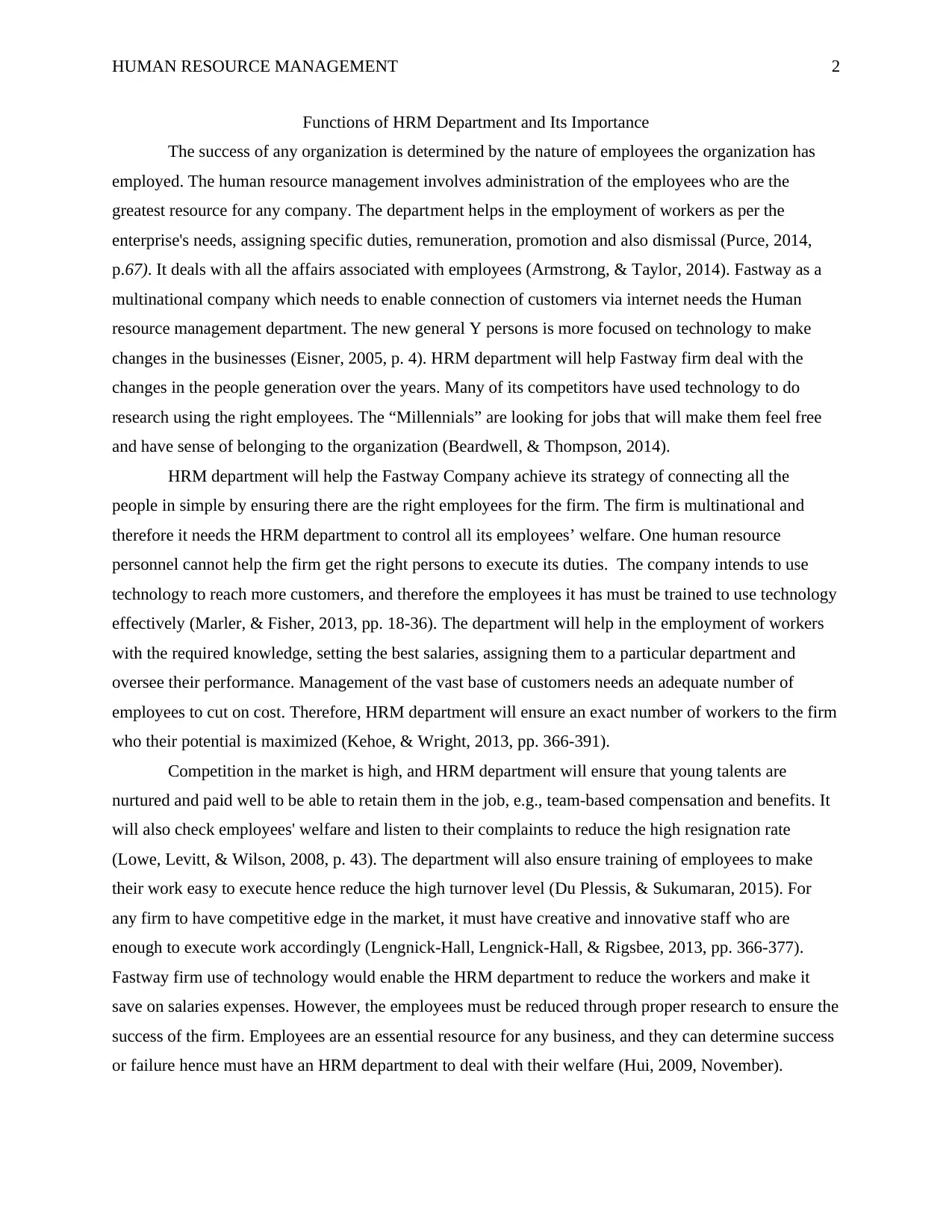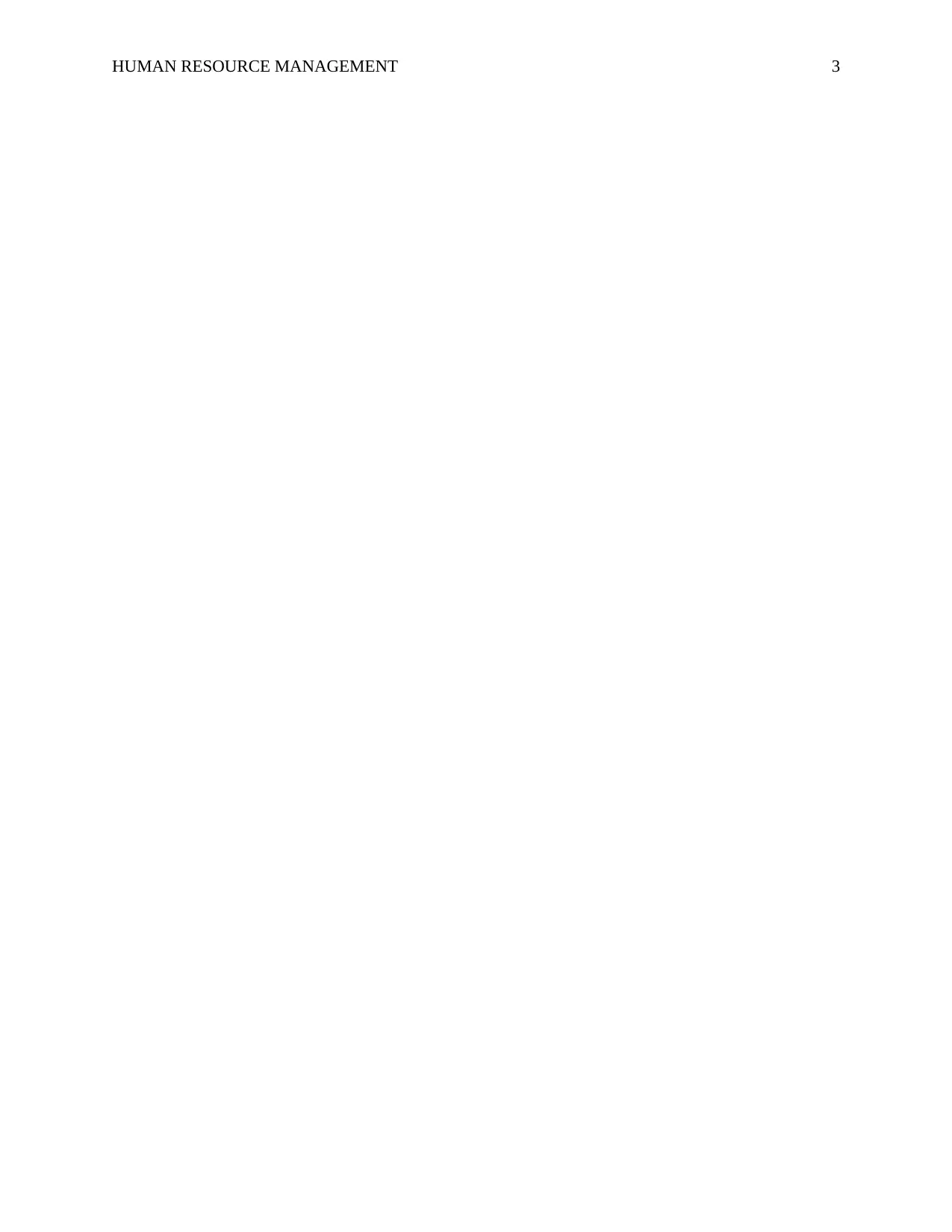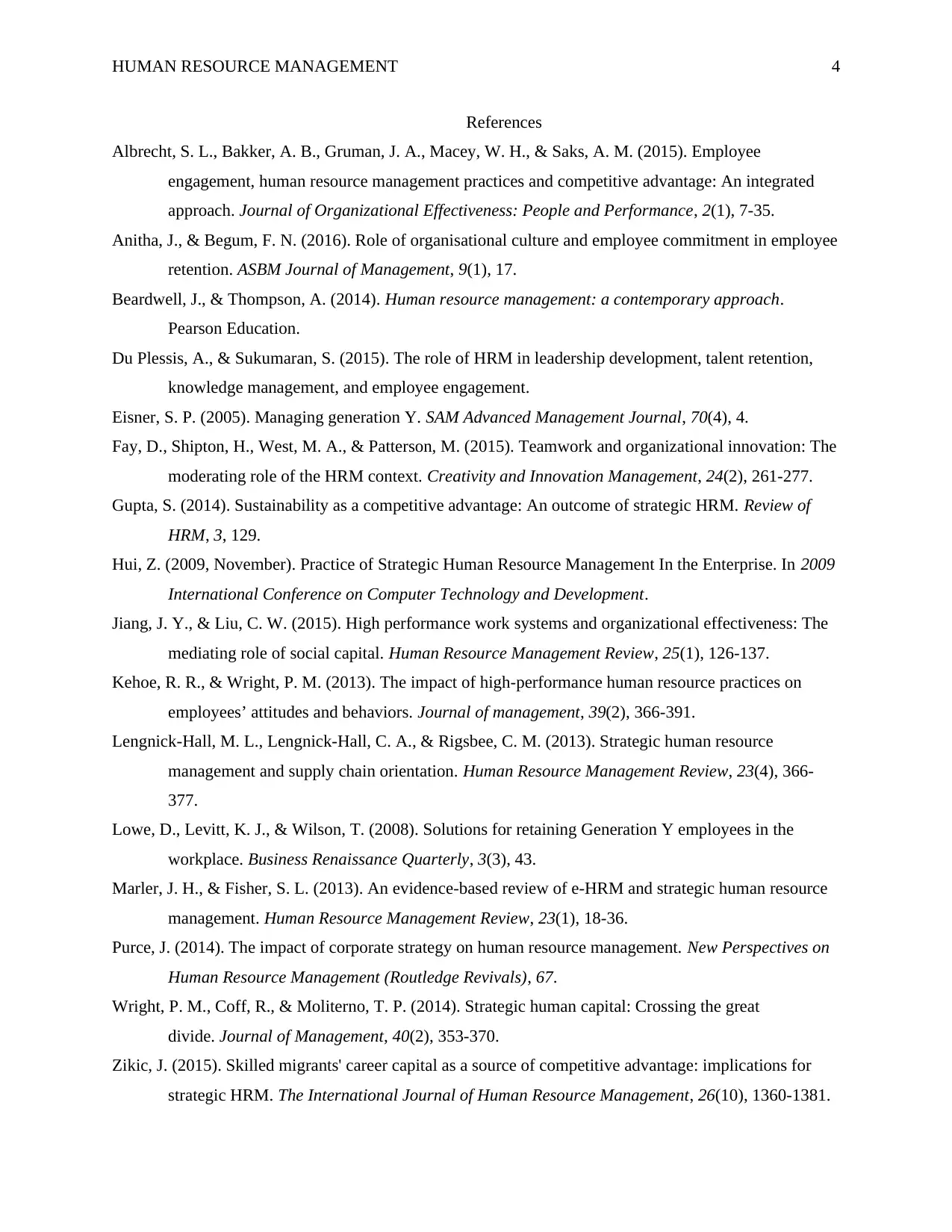Functions of HRM Department and Its Importance for Fastway Company
VerifiedAdded on 2020/04/01
|4
|1208
|75
Report
AI Summary
This report examines the vital functions of a Human Resource Management (HRM) department within an organization, using Fastway as a case study. It emphasizes the significance of HRM in employee administration, including recruitment, assigning duties, compensation, and employee welfare. The report highlights the importance of HRM in addressing generational changes in the workforce, particularly the preferences of Millennials, and the need for technological proficiency among employees. The functions of HRM are discussed in the context of talent retention, training, cost management, and fostering a competitive edge through innovation. The report stresses the value of HRM in ensuring employee well-being and reducing turnover rates, ultimately contributing to the overall success of the firm. The report references various academic sources to support its arguments.

Running Head: HUMAN RESOURCE MANAGEMENT 1
Functions of HRM Department and Its Importance
Student’s Name
University Name
Functions of HRM Department and Its Importance
Student’s Name
University Name
Paraphrase This Document
Need a fresh take? Get an instant paraphrase of this document with our AI Paraphraser

HUMAN RESOURCE MANAGEMENT 2
Functions of HRM Department and Its Importance
The success of any organization is determined by the nature of employees the organization has
employed. The human resource management involves administration of the employees who are the
greatest resource for any company. The department helps in the employment of workers as per the
enterprise's needs, assigning specific duties, remuneration, promotion and also dismissal (Purce, 2014,
p.67). It deals with all the affairs associated with employees (Armstrong, & Taylor, 2014). Fastway as a
multinational company which needs to enable connection of customers via internet needs the Human
resource management department. The new general Y persons is more focused on technology to make
changes in the businesses (Eisner, 2005, p. 4). HRM department will help Fastway firm deal with the
changes in the people generation over the years. Many of its competitors have used technology to do
research using the right employees. The “Millennials” are looking for jobs that will make them feel free
and have sense of belonging to the organization (Beardwell, & Thompson, 2014).
HRM department will help the Fastway Company achieve its strategy of connecting all the
people in simple by ensuring there are the right employees for the firm. The firm is multinational and
therefore it needs the HRM department to control all its employees’ welfare. One human resource
personnel cannot help the firm get the right persons to execute its duties. The company intends to use
technology to reach more customers, and therefore the employees it has must be trained to use technology
effectively (Marler, & Fisher, 2013, pp. 18-36). The department will help in the employment of workers
with the required knowledge, setting the best salaries, assigning them to a particular department and
oversee their performance. Management of the vast base of customers needs an adequate number of
employees to cut on cost. Therefore, HRM department will ensure an exact number of workers to the firm
who their potential is maximized (Kehoe, & Wright, 2013, pp. 366-391).
Competition in the market is high, and HRM department will ensure that young talents are
nurtured and paid well to be able to retain them in the job, e.g., team-based compensation and benefits. It
will also check employees' welfare and listen to their complaints to reduce the high resignation rate
(Lowe, Levitt, & Wilson, 2008, p. 43). The department will also ensure training of employees to make
their work easy to execute hence reduce the high turnover level (Du Plessis, & Sukumaran, 2015). For
any firm to have competitive edge in the market, it must have creative and innovative staff who are
enough to execute work accordingly (Lengnick-Hall, Lengnick-Hall, & Rigsbee, 2013, pp. 366-377).
Fastway firm use of technology would enable the HRM department to reduce the workers and make it
save on salaries expenses. However, the employees must be reduced through proper research to ensure the
success of the firm. Employees are an essential resource for any business, and they can determine success
or failure hence must have an HRM department to deal with their welfare (Hui, 2009, November).
Functions of HRM Department and Its Importance
The success of any organization is determined by the nature of employees the organization has
employed. The human resource management involves administration of the employees who are the
greatest resource for any company. The department helps in the employment of workers as per the
enterprise's needs, assigning specific duties, remuneration, promotion and also dismissal (Purce, 2014,
p.67). It deals with all the affairs associated with employees (Armstrong, & Taylor, 2014). Fastway as a
multinational company which needs to enable connection of customers via internet needs the Human
resource management department. The new general Y persons is more focused on technology to make
changes in the businesses (Eisner, 2005, p. 4). HRM department will help Fastway firm deal with the
changes in the people generation over the years. Many of its competitors have used technology to do
research using the right employees. The “Millennials” are looking for jobs that will make them feel free
and have sense of belonging to the organization (Beardwell, & Thompson, 2014).
HRM department will help the Fastway Company achieve its strategy of connecting all the
people in simple by ensuring there are the right employees for the firm. The firm is multinational and
therefore it needs the HRM department to control all its employees’ welfare. One human resource
personnel cannot help the firm get the right persons to execute its duties. The company intends to use
technology to reach more customers, and therefore the employees it has must be trained to use technology
effectively (Marler, & Fisher, 2013, pp. 18-36). The department will help in the employment of workers
with the required knowledge, setting the best salaries, assigning them to a particular department and
oversee their performance. Management of the vast base of customers needs an adequate number of
employees to cut on cost. Therefore, HRM department will ensure an exact number of workers to the firm
who their potential is maximized (Kehoe, & Wright, 2013, pp. 366-391).
Competition in the market is high, and HRM department will ensure that young talents are
nurtured and paid well to be able to retain them in the job, e.g., team-based compensation and benefits. It
will also check employees' welfare and listen to their complaints to reduce the high resignation rate
(Lowe, Levitt, & Wilson, 2008, p. 43). The department will also ensure training of employees to make
their work easy to execute hence reduce the high turnover level (Du Plessis, & Sukumaran, 2015). For
any firm to have competitive edge in the market, it must have creative and innovative staff who are
enough to execute work accordingly (Lengnick-Hall, Lengnick-Hall, & Rigsbee, 2013, pp. 366-377).
Fastway firm use of technology would enable the HRM department to reduce the workers and make it
save on salaries expenses. However, the employees must be reduced through proper research to ensure the
success of the firm. Employees are an essential resource for any business, and they can determine success
or failure hence must have an HRM department to deal with their welfare (Hui, 2009, November).

HUMAN RESOURCE MANAGEMENT 3
⊘ This is a preview!⊘
Do you want full access?
Subscribe today to unlock all pages.

Trusted by 1+ million students worldwide

HUMAN RESOURCE MANAGEMENT 4
References
Albrecht, S. L., Bakker, A. B., Gruman, J. A., Macey, W. H., & Saks, A. M. (2015). Employee
engagement, human resource management practices and competitive advantage: An integrated
approach. Journal of Organizational Effectiveness: People and Performance, 2(1), 7-35.
Anitha, J., & Begum, F. N. (2016). Role of organisational culture and employee commitment in employee
retention. ASBM Journal of Management, 9(1), 17.
Beardwell, J., & Thompson, A. (2014). Human resource management: a contemporary approach.
Pearson Education.
Du Plessis, A., & Sukumaran, S. (2015). The role of HRM in leadership development, talent retention,
knowledge management, and employee engagement.
Eisner, S. P. (2005). Managing generation Y. SAM Advanced Management Journal, 70(4), 4.
Fay, D., Shipton, H., West, M. A., & Patterson, M. (2015). Teamwork and organizational innovation: The
moderating role of the HRM context. Creativity and Innovation Management, 24(2), 261-277.
Gupta, S. (2014). Sustainability as a competitive advantage: An outcome of strategic HRM. Review of
HRM, 3, 129.
Hui, Z. (2009, November). Practice of Strategic Human Resource Management In the Enterprise. In 2009
International Conference on Computer Technology and Development.
Jiang, J. Y., & Liu, C. W. (2015). High performance work systems and organizational effectiveness: The
mediating role of social capital. Human Resource Management Review, 25(1), 126-137.
Kehoe, R. R., & Wright, P. M. (2013). The impact of high-performance human resource practices on
employees’ attitudes and behaviors. Journal of management, 39(2), 366-391.
Lengnick-Hall, M. L., Lengnick-Hall, C. A., & Rigsbee, C. M. (2013). Strategic human resource
management and supply chain orientation. Human Resource Management Review, 23(4), 366-
377.
Lowe, D., Levitt, K. J., & Wilson, T. (2008). Solutions for retaining Generation Y employees in the
workplace. Business Renaissance Quarterly, 3(3), 43.
Marler, J. H., & Fisher, S. L. (2013). An evidence-based review of e-HRM and strategic human resource
management. Human Resource Management Review, 23(1), 18-36.
Purce, J. (2014). The impact of corporate strategy on human resource management. New Perspectives on
Human Resource Management (Routledge Revivals), 67.
Wright, P. M., Coff, R., & Moliterno, T. P. (2014). Strategic human capital: Crossing the great
divide. Journal of Management, 40(2), 353-370.
Zikic, J. (2015). Skilled migrants' career capital as a source of competitive advantage: implications for
strategic HRM. The International Journal of Human Resource Management, 26(10), 1360-1381.
References
Albrecht, S. L., Bakker, A. B., Gruman, J. A., Macey, W. H., & Saks, A. M. (2015). Employee
engagement, human resource management practices and competitive advantage: An integrated
approach. Journal of Organizational Effectiveness: People and Performance, 2(1), 7-35.
Anitha, J., & Begum, F. N. (2016). Role of organisational culture and employee commitment in employee
retention. ASBM Journal of Management, 9(1), 17.
Beardwell, J., & Thompson, A. (2014). Human resource management: a contemporary approach.
Pearson Education.
Du Plessis, A., & Sukumaran, S. (2015). The role of HRM in leadership development, talent retention,
knowledge management, and employee engagement.
Eisner, S. P. (2005). Managing generation Y. SAM Advanced Management Journal, 70(4), 4.
Fay, D., Shipton, H., West, M. A., & Patterson, M. (2015). Teamwork and organizational innovation: The
moderating role of the HRM context. Creativity and Innovation Management, 24(2), 261-277.
Gupta, S. (2014). Sustainability as a competitive advantage: An outcome of strategic HRM. Review of
HRM, 3, 129.
Hui, Z. (2009, November). Practice of Strategic Human Resource Management In the Enterprise. In 2009
International Conference on Computer Technology and Development.
Jiang, J. Y., & Liu, C. W. (2015). High performance work systems and organizational effectiveness: The
mediating role of social capital. Human Resource Management Review, 25(1), 126-137.
Kehoe, R. R., & Wright, P. M. (2013). The impact of high-performance human resource practices on
employees’ attitudes and behaviors. Journal of management, 39(2), 366-391.
Lengnick-Hall, M. L., Lengnick-Hall, C. A., & Rigsbee, C. M. (2013). Strategic human resource
management and supply chain orientation. Human Resource Management Review, 23(4), 366-
377.
Lowe, D., Levitt, K. J., & Wilson, T. (2008). Solutions for retaining Generation Y employees in the
workplace. Business Renaissance Quarterly, 3(3), 43.
Marler, J. H., & Fisher, S. L. (2013). An evidence-based review of e-HRM and strategic human resource
management. Human Resource Management Review, 23(1), 18-36.
Purce, J. (2014). The impact of corporate strategy on human resource management. New Perspectives on
Human Resource Management (Routledge Revivals), 67.
Wright, P. M., Coff, R., & Moliterno, T. P. (2014). Strategic human capital: Crossing the great
divide. Journal of Management, 40(2), 353-370.
Zikic, J. (2015). Skilled migrants' career capital as a source of competitive advantage: implications for
strategic HRM. The International Journal of Human Resource Management, 26(10), 1360-1381.
1 out of 4
Related Documents
Your All-in-One AI-Powered Toolkit for Academic Success.
+13062052269
info@desklib.com
Available 24*7 on WhatsApp / Email
![[object Object]](/_next/static/media/star-bottom.7253800d.svg)
Unlock your academic potential
Copyright © 2020–2025 A2Z Services. All Rights Reserved. Developed and managed by ZUCOL.





